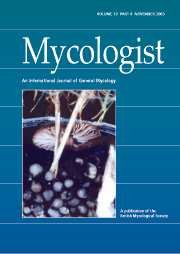Crossref Citations
This article has been cited by the following publications. This list is generated based on data provided by
Crossref.
2000.
21st Century Guidebook to Fungi.
p.
266.
2000.
21st Century Guidebook to Fungi.
p.
392.
Porter, Leila M.
and
Garber, Paul A.
2004.
Goeldi's monkeys: A primate paradox?.
Evolutionary Anthropology: Issues, News, and Reviews,
Vol. 13,
Issue. 3,
p.
104.
Hanson, Amy M.
Hall, Mary Beth
Porter, Leila M.
and
Lintzenich, Barbara
2006.
Composition and Nutritional Characteristics of Fungi Consumed by Callimico goeldii in Pando, Bolivia.
International Journal of Primatology,
Vol. 27,
Issue. 1,
p.
323.
Porter, Leila M.
Sterr, Sarah M.
and
Garber, Paul A.
2007.
Habitat Use and Ranging Behavior of Callimico goeldii.
International Journal of Primatology,
Vol. 28,
Issue. 5,
p.
1035.
Murat, C.
Mello, A.
Abbà, S.
Vizzini, A.
and
Bonfante, P.
2008.
Mycorrhiza.
p.
707.
Porter, Leila M.
and
Garber, Paul A.
2010.
Mycophagy and its influence on habitat use and ranging patterns in Callimico goeldii.
American Journal of Physical Anthropology,
Vol. 142,
Issue. 3,
p.
468.
Hilário, Renato R.
and
Ferrari, Stephen F.
2010.
Feeding ecology of a group of buffy‐headed marmosets (Callithrix flaviceps): fungi as a preferred resource.
American Journal of Primatology,
Vol. 72,
Issue. 6,
p.
515.
Bellgard, Stanley
and
Williams, Stephen
2011.
Response of Mycorrhizal Diversity to Current Climatic Changes.
Diversity,
Vol. 3,
Issue. 1,
p.
8.
Hilário, Renato R.
and
Ferrari, Stephen Francis
2011.
Why Feed on Fungi? The Nutritional Content of Sporocarps Consumed by Buffy-Headed Marmosets, Callithrix flaviceps (Primates: Callitrichidae), in Southeastern Brazil.
Journal of Chemical Ecology,
Vol. 37,
Issue. 2,
p.
145.
SAWADA, Akiko
2014.
Mycophagy among Primates.
Primate Research,
Vol. 30,
Issue. 1,
p.
5.
TSUJINO, Riyou
and
YUMOTO, Takakazu
2014.
Species Interactions and the Roles of Primates in the Ecosystem.
Primate Research,
Vol. 30,
Issue. 1,
p.
79.
Połatyńska, Małgorzata
2014.
Small mammals feeding on hypogeous fungi.
Folia Biologica et Oecologica,
Vol. 10,
Issue. ,
p.
89.
Sawada, Akiko
Sato, Hirotoshi
Inoue, Eiji
Otani, Yosuke
and
Hanya, Goro
2014.
Mycophagy among Japanese macaques in Yakushima: fungal species diversity and behavioral patterns.
Primates,
Vol. 55,
Issue. 2,
p.
249.
Owens, Jacob R.
Honarvar, Shaya
Nessel, Mark
and
Hearn, Gail W.
2015.
From frugivore to folivore: Altitudinal variations in the diet and feeding ecology of the Bioko Island drill (Mandrillus leucophaeus poensis).
American Journal of Primatology,
Vol. 77,
Issue. 12,
p.
1263.
Claridge, Andrew W.
Paull, David J.
and
Cunningham, Ross B.
2016.
Oils ain’t oils: can truffle-infused food additives improve detection of rare and cryptic mycophagous mammals?.
Australian Mammalogy,
Vol. 38,
Issue. 1,
p.
12.
2016.
Fungi in Ecosystem Processes, Second Edition.
p.
191.
Kües, Ursula
Khonsuntia, Weeradej
Subba, Shanta
and
Dörnte, Bastian
2018.
Physiology and Genetics.
p.
149.
Guevara-Guerrero, Gonzalo
Bonito, Gregory
Smith, Matthew E.
Healy, Roseanne
Grupe, Arthur
Cazares, Efren
Castellano, Michael A.
and
Trappe, James M.
2018.
Tuber aztecorum sp. nov., a truffle species from Mexico belonging to the Maculatum clade (Tuberaceae, Pezizales).
MycoKeys,
Vol. 30,
Issue. ,
p.
61.
Li, Ziwei
Luo, Rui
Zhang, Yuexin
Yan, Xiufeng
and
Pang, Qiuying
2018.
Effective protein extraction from mycelium and fruiting body of Auricularia auricula for proteomics studies.
International Journal of Food Properties,
Vol. 21,
Issue. 1,
p.
2156.




